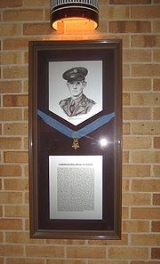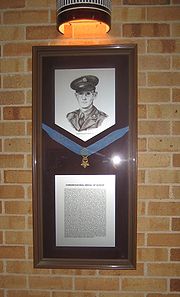
George D. Keathley
Encyclopedia
George Dennis Keathley was a staff sergeant in the United States Army
who received the Medal of Honor
for his actions during World War II
.
in 1907, Keathley attended Olney High School and Cameron Junior College. He graduated from the Agricultural & Mechanical College of Texas, today known as Texas A&M University
, in 1937.
He joined the Army from Lamesa, Texas
, and by September 14, 1944, was serving as a staff sergeant in Company B, 338th Infantry Regiment, 85th Infantry Division. During an enemy counterattack on that day, at Mount Altuzzo, Italy
, Keathley took command of two platoons which had been left leaderless due to heavy casualties. He organized the platoons' defense, gathered ammunition, and encouraged his men even after being severely wounded. He died of his injuries shortly after the attack was repulsed. For these actions, Keathley was posthumously awarded the Medal of Honor six months later, on March 29, 1945.
Keathley, aged 37 at his death, was buried at the Florence American Cemetery in Florence
, Italy.
Keathley's Medal of Honor is on permanent display at Texas A&M University's Sanders Corps of Cadets Center
. The medal was donated to the museum by his family on July 17, 2009. Also at Texas A&M is the Keathley Hall dormitory, named in his honor.

United States Army
The United States Army is the main branch of the United States Armed Forces responsible for land-based military operations. It is the largest and oldest established branch of the U.S. military, and is one of seven U.S. uniformed services...
who received the Medal of Honor
Medal of Honor
The Medal of Honor is the highest military decoration awarded by the United States government. It is bestowed by the President, in the name of Congress, upon members of the United States Armed Forces who distinguish themselves through "conspicuous gallantry and intrepidity at the risk of his or her...
for his actions during World War II
World War II
World War II, or the Second World War , was a global conflict lasting from 1939 to 1945, involving most of the world's nations—including all of the great powers—eventually forming two opposing military alliances: the Allies and the Axis...
.
Biography
Born in Olney, TexasOlney, Texas
Olney is a city in Young County, Texas, United States. The population was 3,236 in 2008.-Geography:Olney is located at ....
in 1907, Keathley attended Olney High School and Cameron Junior College. He graduated from the Agricultural & Mechanical College of Texas, today known as Texas A&M University
Texas A&M University
Texas A&M University is a coeducational public research university located in College Station, Texas . It is the flagship institution of the Texas A&M University System. The sixth-largest university in the United States, A&M's enrollment for Fall 2011 was over 50,000 for the first time in school...
, in 1937.
He joined the Army from Lamesa, Texas
Lamesa, Texas
Lamesa is a city in and the county seat of Dawson County, Texas, United States. The population was 9,952 at the 2000 census. Located south of Lubbock on the Llano Estacado, Lamesa was founded in 1903. Most of the economy is based on cattle ranching and cotton farming. The Preston E...
, and by September 14, 1944, was serving as a staff sergeant in Company B, 338th Infantry Regiment, 85th Infantry Division. During an enemy counterattack on that day, at Mount Altuzzo, Italy
Italy
Italy , officially the Italian Republic languages]] under the European Charter for Regional or Minority Languages. In each of these, Italy's official name is as follows:;;;;;;;;), is a unitary parliamentary republic in South-Central Europe. To the north it borders France, Switzerland, Austria and...
, Keathley took command of two platoons which had been left leaderless due to heavy casualties. He organized the platoons' defense, gathered ammunition, and encouraged his men even after being severely wounded. He died of his injuries shortly after the attack was repulsed. For these actions, Keathley was posthumously awarded the Medal of Honor six months later, on March 29, 1945.
Keathley, aged 37 at his death, was buried at the Florence American Cemetery in Florence
Florence
Florence is the capital city of the Italian region of Tuscany and of the province of Florence. It is the most populous city in Tuscany, with approximately 370,000 inhabitants, expanding to over 1.5 million in the metropolitan area....
, Italy.
Keathley's Medal of Honor is on permanent display at Texas A&M University's Sanders Corps of Cadets Center
Sanders Corps of Cadets Center
The Sam Houston Sanders Corps of Cadets Center is a museum on the campus of Texas A&M University in College Station, Texas, dedicated to the school's Corps of Cadets....
. The medal was donated to the museum by his family on July 17, 2009. Also at Texas A&M is the Keathley Hall dormitory, named in his honor.
Medal of Honor citation

For conspicuous gallantry and intrepidity at risk of life above and beyond the call of duty, in action on the western ridge of Mount Altuzzo, Italy. After bitter fighting his company had advanced to within 50 yards of the objective, where it was held up due to intense enemy sniper, automatic, small arms, and mortar fire. The enemy launched 3 desperate counterattacks in an effort to regain their former positions, but all 3 were repulsed with heavy casualties on both sides. All officers and noncommissioned officers of the 2d and 3d platoons of Company B had become casualties, and S/Sgt. Keathley, guide of the 1st platoon, moved up and assumed command of both the 2d and 3d platoons, reduced to 20 men. The remnants of the 2 platoons were dangerously low on ammunition, so S/Sgt. Keathley, under deadly small arms and mortar fire, crawled from 1 casualty to another, collecting their ammunition and administering first aid. He then visited each man of his 2 platoons, issuing the precious ammunition he had collected from the dead and wounded, and giving them words of encouragement. The enemy now delivered their fourth counterattack, which was approximately 2 companies in strength. In a furious charge they attacked from the front and both flanks, throwing hand grenades, firing automatic weapons, and assisted by a terrific mortar barrage. So strong was the enemy counterattack that the company was given up for lost. The remnants of the 2d and 3d platoons of Company B were now looking to S/Sgt. Keathley for leadership. He shouted his orders precisely and with determination and the men responded with all that was in them. Time after time the enemy tried to drive a wedge into S/Sgt. Keathley's position and each time they were driven back, suffering huge casualties. Suddenly an enemy hand grenade hit and exploded near S/Sgt. Keathley, inflicting a mortal wound in his left side. However, hurling defiance at the enemy, he rose to his feet. Taking his left hand away from his wound and using it to steady his rifle, he fired and killed an attacking enemy soldier, and continued shouting orders to his men. His heroic and intrepid action so inspired his men that they fought with incomparable determination and viciousness. For 15 minutes S/Sgt. Keathley continued leading his men and effectively firing his rifle. He could have sought a sheltered spot and perhaps saved his life, but instead he elected to set an example for his men and make every possible effort to hold his position. Finally, friendly artillery fire helped to force the enemy to withdraw, leaving behind many of their number either dead or seriously wounded. S/Sgt. Keathley died a few moments later. Had it not been for his indomitable courage and incomparable heroism, the remnants of 3 rifle platoons of Company B might well have been annihilated by the overwhelming enemy attacking force. His actions were in keeping with the highest traditions of the military service.
See also
- List of Medal of Honor recipients for World War II

